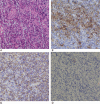Successful management of octreotide-insensitive thyrotropin-secreting pituitary adenoma with bromocriptine and surgery: A case report and literature review
- PMID: 28885368
- PMCID: PMC6393027
- DOI: 10.1097/MD.0000000000008017
Successful management of octreotide-insensitive thyrotropin-secreting pituitary adenoma with bromocriptine and surgery: A case report and literature review
Erratum in
-
Erratum: Successful management of octreotide-insensitive thyrotropin-secreting pituitary adenoma with bromocriptine and surgery: A case report and literature review: Erratum.Medicine (Baltimore). 2017 Sep 29;96(39):e8225. doi: 10.1097/MD.0000000000008225. eCollection 2017 Sep. Medicine (Baltimore). 2017. PMID: 31305716 Free PMC article.
Abstract
Rationale: Case reports concerning the value of dopamine agonists in the treatment of patients with thyrotropin-secreting pituitary adenoma (TSHoma) are limited. Herein, we present a rare case of octreotide-insensitive TSHoma responding to bromocriptine therapy.
Patient concerns: A 45-year-old Chinese man was admitted to Peking Union Medical College Hospital with marked clinical manifestations of hyperthyroidism.
Diagnoses: Thyroid function tests demonstrated elevated concentrations of free thyroid hormones in the presence of normal thyrotropin. Magnetic resonance imaging findings showed a pituitary microadenoma on the right side of the sellar region. Based on characteristic endocrine results and neuroimaging findings, the patient was diagnosed with TSHoma.
Interventions: Most patients with TSHomas are significantly responsive to somatostatin analog treatment. However, our patient was orally administered with bromocriptine to normalize thyroid function as assessed by suppression tests conducted prior to surgery. A transsphenoidal surgery was performed by an experienced neurosurgeon for tumor removal.
Outcomes: The pituitary lesion was totally resected. Following the operation, the results of thyroid function tests were immediately within reference limits. During the follow-up, there was no residual or recurrent tumor.
Lessons: Attention should be paid to the role of dopamine agonists such as bromocriptine and cabergoline as adjuvant therapy for TSHomas that are insensitive to traditional medical treatment by somatostatin analogs.
Figures




Similar articles
-
Ectopic pituitary adenoma of the TSH-secreting sphenoidal sinus with excellent response to somatostatin analogs. Theory of the embryogenesis and literature review from a clinical case.Steroids. 2020 Feb;154:108535. doi: 10.1016/j.steroids.2019.108535. Epub 2019 Nov 6. Steroids. 2020. PMID: 31704334 Review.
-
[Thyrotropin secreting adenoma].Nihon Rinsho. 1993 Oct;51(10):2701-5. Nihon Rinsho. 1993. PMID: 8254942 Review. Japanese.
-
Pathological study of thyrotropin-secreting pituitary adenoma: plurihormonality and medical treatment.Acta Neuropathol. 2004 Aug;108(2):147-53. doi: 10.1007/s00401-004-0863-x. Epub 2004 Jun 5. Acta Neuropathol. 2004. PMID: 15185102
-
ENDOCRINE TUMOURS: Thyrotropin-secreting pituitary adenoma: a structured review of 535 adult cases.Eur J Endocrinol. 2021 Jul 12;185(2):R65-R74. doi: 10.1530/EJE-21-0162. Eur J Endocrinol. 2021. PMID: 34132199
-
Challenges in the Management of a 7-Year-Old Child with Thyrotropin-Secreting Pituitary Adenoma and the Review of the Literature.Horm Res Paediatr. 2023;96(5):527-537. doi: 10.1159/000529070. Epub 2023 Jan 11. Horm Res Paediatr. 2023. PMID: 36630941 Review.
Cited by
-
Progress in the Pathogenesis, Diagnosis, and Treatment of TSH-Secreting Pituitary Neuroendocrine Tumor.Front Endocrinol (Lausanne). 2020 Nov 27;11:580264. doi: 10.3389/fendo.2020.580264. eCollection 2020. Front Endocrinol (Lausanne). 2020. PMID: 33329389 Free PMC article. Review.
-
Erratum: Successful management of octreotide-insensitive thyrotropin-secreting pituitary adenoma with bromocriptine and surgery: A case report and literature review: Erratum.Medicine (Baltimore). 2017 Sep 29;96(39):e8225. doi: 10.1097/MD.0000000000008225. eCollection 2017 Sep. Medicine (Baltimore). 2017. PMID: 31305716 Free PMC article.
-
Thyroid-Stimulating Hormone-Secreting Pituitary Adenoma: Two Cases With Challenging Diagnosis and Management.Case Rep Endocrinol. 2025 Apr 14;2025:5103475. doi: 10.1155/crie/5103475. eCollection 2025. Case Rep Endocrinol. 2025. PMID: 40259920 Free PMC article.
-
Chemotherapy of Capecitabine plus Temozolomide for Refractory Pituitary Adenoma after Tumor Resection and Its Impact on Serum Prolactin, IGF-1, and Growth Hormone.J Oncol. 2022 Mar 21;2022:8361775. doi: 10.1155/2022/8361775. eCollection 2022. J Oncol. 2022. PMID: 35356252 Free PMC article.
References
-
- Clarke MJ, Erickson D, Castro MR, et al. Thyroid-stimulating hormone pituitary adenomas. J Neurosurg 2008;109:17–22. - PubMed
-
- Jailer JW, Holub DA. Remission of Graves’ disease following radiotherapy of a pituitary neoplasm. Am J Med 1960;28:497–500. - PubMed
-
- Onnestam L, Berinder K, Burman P, et al. National incidence and prevalence of TSH-secreting pituitary adenomas in Sweden. J Clin Endocrinol Metab 2013;98:626–35. - PubMed
-
- Sarlis NJ, Gourgiotis L, Koch CA, et al. MR imaging features of thyrotropin-secreting pituitary adenomas at initial presentation. AJR Am J Roentgenol 2003;181:577–82. - PubMed
Publication types
MeSH terms
Substances
LinkOut - more resources
Full Text Sources
Other Literature Sources
Medical

